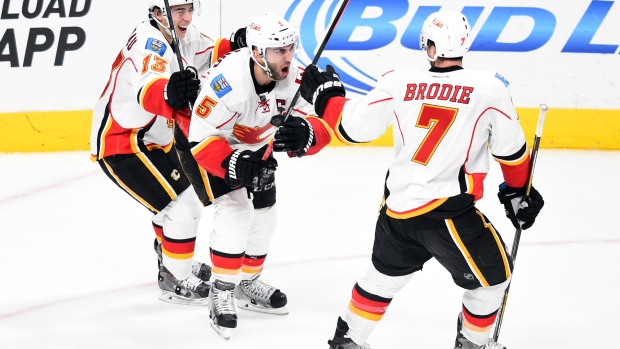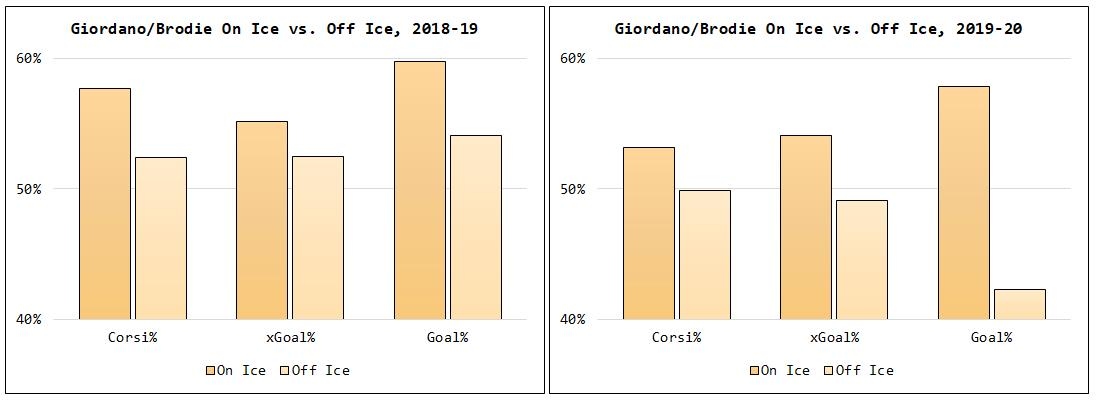Jan 30, 2020
Giordano and Brodie pairing continues to carry Calgary
The Flames’ dynamic defensive duo still dominates, but the team has been dreadful when the top pairing is off the ice, Travis Yost writes.
By Travis Yost

The Calgary Flames – 7-2-1 in their past 10 games – are surging in the standings. One of the biggest reasons Calgary has been able to shake off an early season lull is the play of their top pairing and one of the best blueline duos in the National Hockey League: Mark Giordano and T.J. Brodie.
The Giordano and Brodie pairing has been a mainstay for Calgary for a couple of seasons now, but it’s still so impressive to see how dominant they are as a unit and how complementary their skill sets remain.
It’s not as if they are two spring chickens coming into their own as professionals – Giordano is a 36-year- old in his 14th season at the NHL level, while the “younger” Brodie will turn 30 this summer.
Giordano was always going to age gracefully. He’s a half-step slower than he was in his prime, and every so often you catch him in a sequence with a unicorn like Oilers star Connor McDavid (like last night). But the core strengths of his game – hockey intelligence, the ability to seamlessly find transition passing lanes for forwards flying through the neutral zone and spatial awareness when it comes to off-puck defensive play – have remained intact and give opposition attackers fits on a nightly basis.
But every Batman needs a Robin, especially when Batman is starting to eye the 1,000-game mark. That’s where Brodie has been so instrumental in sustaining the quality of the pairing. Brodie remains an exceptional skater, is competent at tying up attackers at the blueline, and is capable with the puck on his stick.
Perhaps, above all else, it’s the combination of puck skills that make this pairing so dominant. Giordano and Brodie are both quality puck movers and handlers, so in many instances a shift against the duo means very few touches of the puck for the opposition.
We see that in the underlying numbers. The Giordano and Brodie pairing has been outstanding for some time now and it is again true in the 2019-20 season:

The Giordano and Brodie pairing tends to play quite a bit with Calgary’s better forwards, unsurprisingly – the most common forwards intermixed with Calgary’s top pairing includes Elias Lindholm, Johnny Gaudreau, Matthew Tkachuk and Sean Monahan.
The Flames have been quite good this season when their top players are on the ice. The difference from last year’s 107-point season to this year’s 94-point pace is that the team is dreadful when the Giordano and Brodie pairing is off the ice, particularly at 5-on-5. (Special teams play, for what it is worth, is right around league average for both the power play and penalty kill – very much in line with what we saw a season ago.)
From a personnel standpoint, it does pose an interesting question to the Calgary front office as the trade deadline approaches. They know their top pairing is one they can lean on for 25 minutes a night. But can the same be said for Noah Hanifin, Oliver Kylington, Rasmus Andersson and Travis Hamonic? All four players carry some form of pedigree, but their goal differentials have been ghastly this season.
Do you stay the course and hope that the rest of the group – certainly younger with more potential, but struggling to varying degrees in the 2019-20 season – figures it out during the stretch run? Or do you apportion more of the problems to the third and fourth lines, which have similarly struggled, except in those fleeting minutes they get to play with the top pair?
Regardless, these are fascinating times in Calgary. The team has an incredibly reliable top pairing that gives them puck dominance and favourable goal differentials in the ice time they chew up. But the rest of the team hasn’t offered nearly as much, and that’s why Calgary’s fate is still an unknown as we enter the stretch run of the regular season.
Data via NaturalStatTrick, Hockey Reference, and HockeyDB

